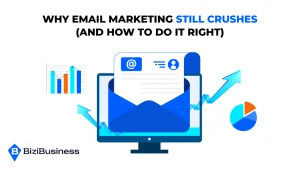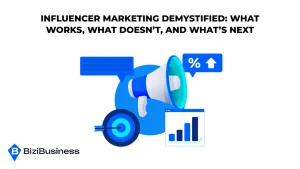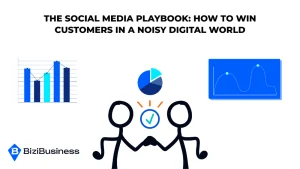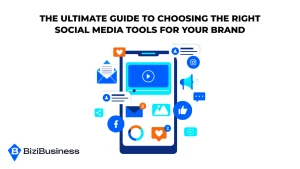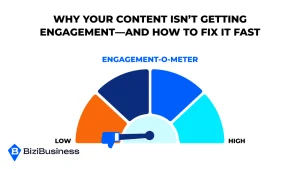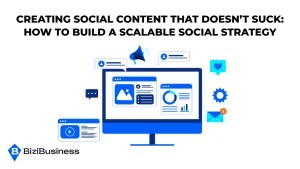BiziTopics
Cross-Channel Email Marketing: Where Strategy Meets Synergy
BiziBusiness
Aug 12, 2025
16 min read
Email is powerful—but in a multichannel world, it’s no longer enough on its own. Today’s customers bounce between inboxes, social feeds, websites, and apps. If your message only lives in one channel, it’s easy to miss—or forget.
Cross-channel email marketing connects the dots. It aligns email with SMS, social, web, and ads to create seamless, personalized experiences that drive real results.
This guide shows you how to move beyond isolated sends—and build integrated strategies that convert across every touchpoint.
What Is Cross-Channel Email Marketing?
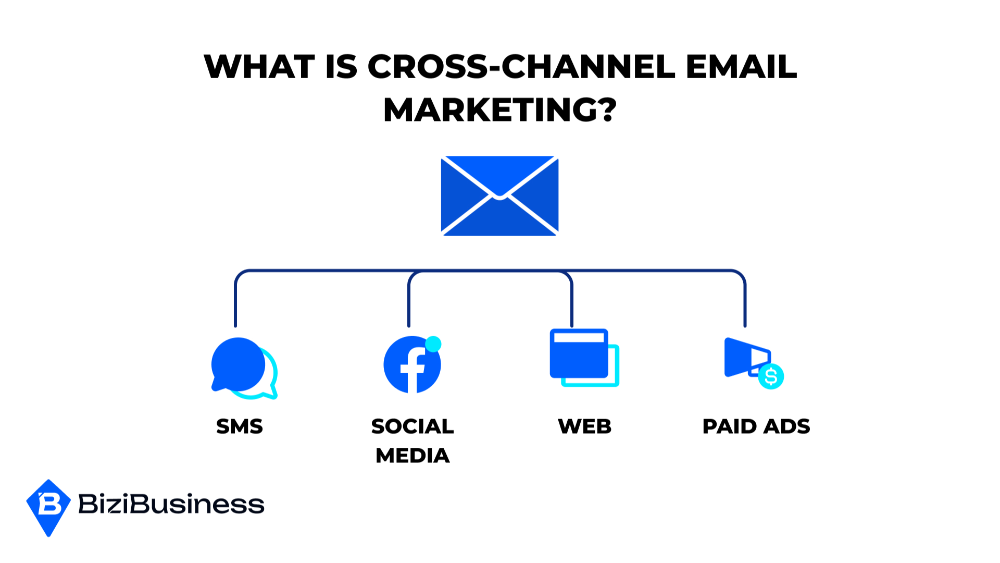
Cross-channel email marketing is the practice of integrating your email efforts with other customer touchpoints—like SMS, social media, web, and paid ads—to create a unified, consistent experience.
It’s different from simply being “multichannel,” where each platform operates independently. Cross-channel means each message works together, in sync, across the journey. The goal isn’t just presence—it’s orchestration.
When a customer:
- Abandons a cart and gets an email, then a reminder via SMS
- Signs up via social and receives a personalized email series
- Clicks an email and sees a follow-up retargeting ad with the same offer
…that’s cross-channel marketing at work.
Why it matters:
Consumers expect brands to remember them and speak to them consistently—no matter where they show up. When email works in tandem with other channels, it not only improves engagement but also boosts conversion, retention, and brand trust.
Email isn’t the whole journey—but it can be the most powerful part when it’s connected to everything else.
Key Channels To Integrate With Email
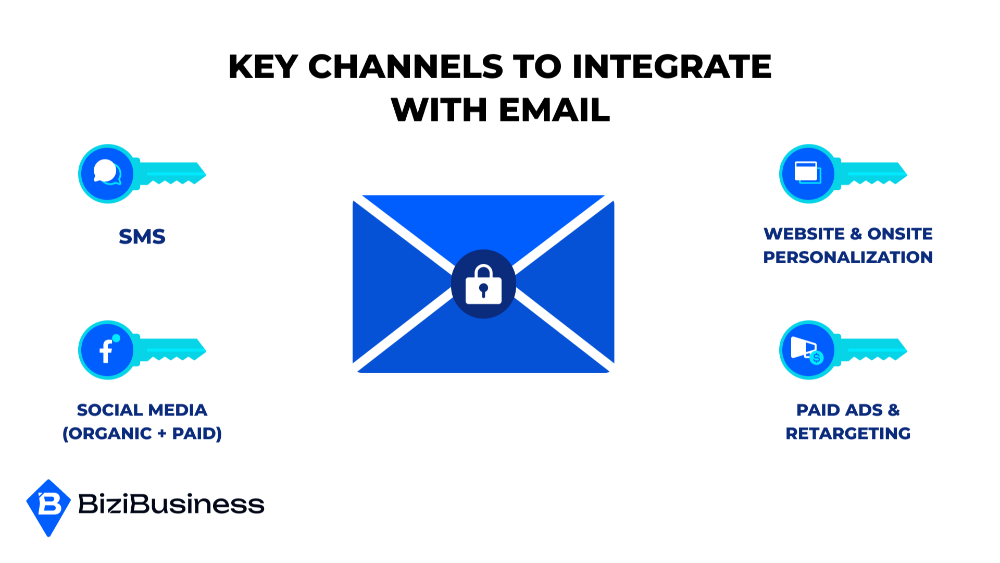
Email marketing becomes exponentially more powerful when it doesn’t work alone. Integrating email with other high-impact channels creates a connected ecosystem—one that speaks to users wherever they are and nudges them forward in a cohesive, personalized journey.
Below are the five most effective channels to integrate with email, along with how they complement each other and deliver results.
1. SMS (Short Message Service)
Why it matters:
SMS delivers immediacy. With open rates over 90%, it’s ideal for short, time-sensitive messages like reminders, limited-time offers, and transactional updates.
How to integrate with email:
- Multi-touch sequences: Follow up an abandoned cart email with an SMS nudge one day later.
- Double confirmation: Send a transactional confirmation email, then a text with a delivery ETA or tracking link.
- Campaign urgency: Send a “final hours” SMS to back up a promo email and capture last-minute conversions.
Strategic benefit:
Email builds narrative; SMS accelerates action. Together, they reinforce each other and meet your audience where they are—in the inbox and in their pocket.
2. Social Media (Organic + Paid)
Why it matters:
Your audience spends hours scrolling social platforms every day. Syncing your email campaigns with social touchpoints creates recognition and multiplies message retention.
How to integrate with email:
- Ad retargeting: Upload email segments to Meta or LinkedIn to serve ads aligned with your campaign theme.
- Lead gen loop: Run social ads to gated content, then nurture those leads via email drip campaigns.
- Content consistency: Repurpose social UGC, testimonials, or influencer shoutouts in emails to drive credibility.
Strategic benefit:
Email design is trusted and personal; social is public and viral. Integration bridges awareness and action, boosting campaign exposure and response.
3. Website & Onsite Personalization
Why it matters:
The website is where most conversions happen. When email campaigns send traffic to a site that reflects the email’s message, design, and CTA, conversion rates go up.
How to integrate with email:
- Behavioral triggers: Send emails based on website actions (e.g., browsed product pages but didn’t buy).
- Personalized landing pages: Route email clicks to content tailored to the recipient’s segment, status, or interest.
- Onsite overlays or banners: Show popups or slide-ins to reinforce the same promotion or story from the user’s latest email.
Strategic benefit:
Your email opens the door; your website should continue the conversation. Personalization tightens that loop.
4. Paid Ads & Retargeting
Why it matters:
Not everyone opens your emails—but they might still engage with your brand elsewhere. Integrating email with paid ad strategies keeps your message visible beyond the inbox.
How to integrate with email:
- Custom audiences: Target email non-openers with reminder ads or a secondary offer.
- Email to ads: Reinforce a campaign’s message (e.g., product launch) via Google Display or Facebook Ads.
- Lookalike acquisition: Use top-performing email segments to create lookalike audiences for new customer acquisition.
Strategic benefit:
Cross-channel retargeting ensures your highest-value messages don’t disappear in a crowded inbox—they follow your audience wherever they go online.
5. Push Notifications & In-App Messaging
Why it matters:
For mobile-first and product-led brands, these tools deliver frictionless, in-the-moment communication.
How to integrate with email:
- Product usage reminders: If a user opens an onboarding email but doesn’t take action, send an in-app nudge.
- Multi-channel winback: Pair a re-engagement email with a timely push notification—especially for time-limited offers.
- Progress nudges: Coordinate push messages and emails to show users their next step (e.g., complete profile, upgrade plan).
Strategic benefit:
Push and in-app messages drive micro-actions; email supports deeper storytelling and offers. Together, they guide users through product and lifecycle flows.
Mapping The Customer Journey Across Channels
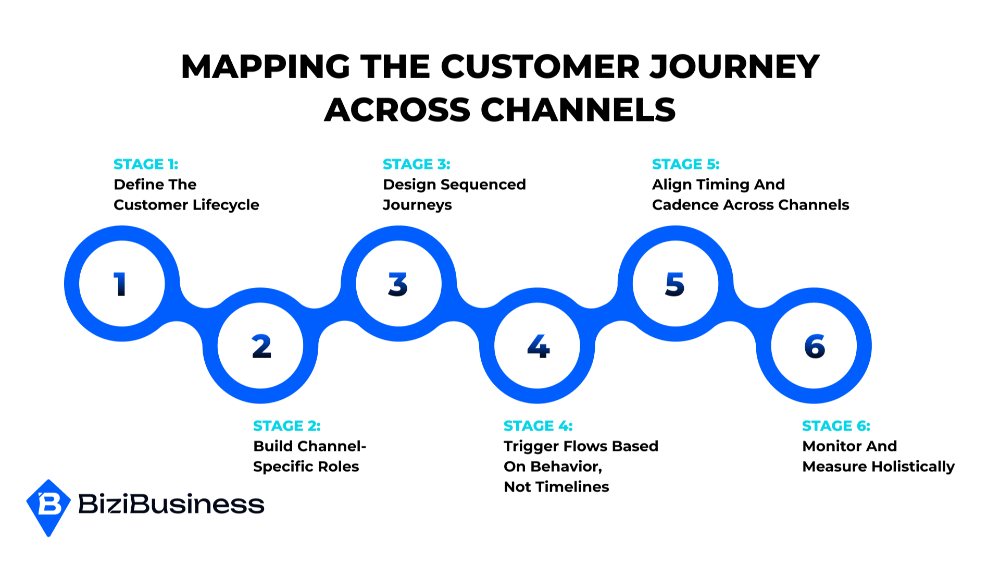
A successful cross-channel strategy isn’t about blasting the same message everywhere. It’s about creating a coordinated, intelligent sequence of touchpoints that respond to where your customer is in their journey—and guide them toward action.
Mapping the customer journey is how you turn disconnected emails, ads, and messages into a unified experience. It aligns content, channels, and timing so that your brand always feels relevant and responsive—never random or repetitive.
Stage 1: Define the Customer Lifecycle
Before you can connect your channels, you need to understand your customers’ path. Most journeys follow this structure:
| Stage | Customer Mindset | Primary Goal |
|---|---|---|
| Awareness | “Who are you?” | Introduce brand, capture attention |
| Consideration | “Should I trust you?” | Build credibility and interest |
| Conversion | “Is this the right time?” | Drive the decision and reduce friction |
| Onboarding | “How do I get value from this?” | Activate usage and early satisfaction |
| Retention | “Is this still helping me?” | Deepen value, build loyalty |
| Reactivation | “I forgot about you—or don’t care anymore” | Reignite interest and re-engage |
Each stage demands different content, tone, and channel mix. Email is usually the core narrative thread across these stages, but it’s more effective when complemented by supporting channels.
Stage 2: Build Channel-Specific Roles
Each channel plays a distinct part in the user journey. Rather than duplicate content, define what each channel does best.
- Email: Rich content, long-form storytelling, personalized nurture
- SMS: Immediate alerts, reminders, urgent action triggers
- Social: Visibility, social proof, discovery moments
- Paid Ads: Repetition, retargeting, decision reinforcement
- Website/In-app: Deep engagement, conversion, onboarding
- Push Notifications: Timely nudges for mobile and app users
Mapping each channel’s purpose helps you avoid overlap, reduce fatigue, and deliverbility the right message in the right place.
Stage 3: Design Sequenced Journeys
Think of your journey as a choreographed experience, not a list building of one-off campaigns. For example:
Cart Abandonment Sequence:
- Day 0: Email reminder with product details and reviews
- Day 1: SMS with urgency (“Only 2 left in stock!”)
- Day 2: Retargeting ad showing item with incentive
- Day 3: On-site banner on homepage if user returns
- Day 4: Follow-up email with FAQ or trust message (e.g., free returns)
Each step is connected, increasing relevance and reducing friction. And each channel reinforces—not repeats—the same message.
Stage 4: Trigger Flows Based on Behavior, Not Timelines
Scheduled drips are easy—but they often miss the mark. Instead, use behavioral triggers to move users between stages and channels based on what they actually do.
Examples:
- If a user opens an email but doesn’t click, follow up with a brief SMS.
- If a user clicks but doesn’t convert, add them to a retargeting ad flow.
- If a user visits your pricing page, trigger a smart follow-up email + in-app prompt.
- If a user downloads content, show product tips via push notification.
This adaptive logic ensures your journey remains relevant no matter how fast (or slow) a customer moves.
Stage 5: Align Timing and Cadence Across Channels
You want to feel present, not overwhelming. That means managing when and how often messages are sent—not just what they say.
Tips to balance timing:
- Stagger channels: If an email goes out today, schedule an ad or SMS for tomorrow.
- Match channel to intent: Email for education, SMS for urgency, push for activation.
- Avoid stack fatigue: Never trigger every channel at once unless absolutely necessary (e.g., flash sale).
Sequencing creates rhythm. Rhythm builds anticipation—and trust.
Stage 6: Monitor and Measure Holistically
The final—and often missing—piece of cross-channel journey mapping is analytics and metrics. Looking at email open rates alone isn’t enough. You need to see how channels perform together.
What to track:
- Drop-off points: where people disengage
- Cross-channel influence: did an SMS boost email clicks?
- Time to conversion across journeys
- Combined revenue from orchestrated campaigns
- Assisted conversions: which channel supported the win?
Use tools like Google Analytics, your ESP, or customer journey dashboards to map full-funnel performance—not just isolated metrics.
Data And Systems – Connecting The Stack
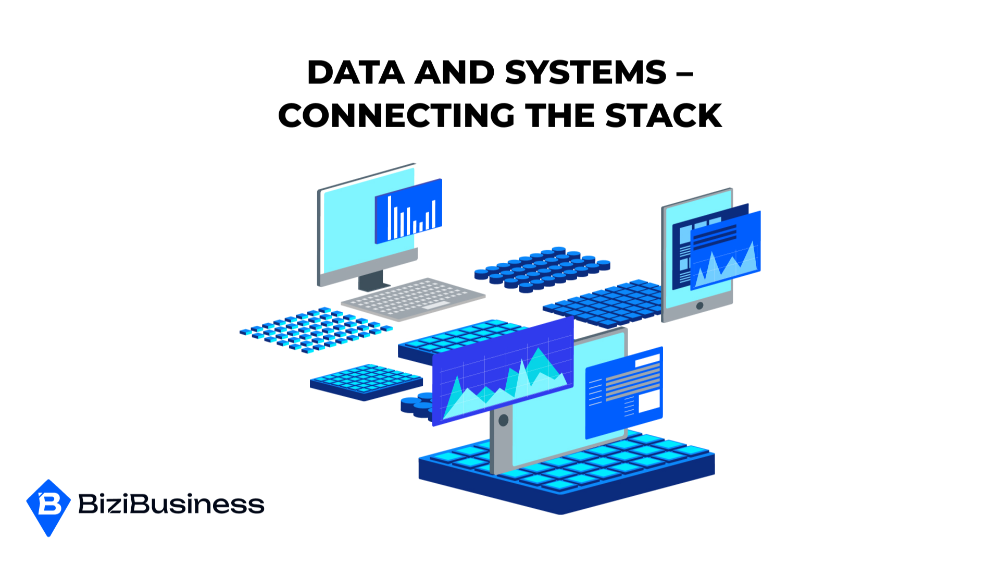
Cross-channel marketing only works when your systems talk to each other—and when your data is accurate, accessible, and actionable. Without a connected stack, even the best strategy falls flat.
This section breaks down how to unify your data, connect your platforms, and create a centralized foundation for orchestrating seamless, effective campaigns across email, SMS, web, ads, and more.
Why Integration Matters
In a disconnected system:
- You can’t trigger the right message at the right time
- You risk sending irrelevant or redundant content
- You miss out on performance insights across the customer lifecycle
In a connected system:
- Each channel draws from the same source of truth
- Triggers and automations respond to real-time behavior
- Attribution becomes clearer, and ROI becomes measurable
Integration isn’t optional—it’s the enabler of effective cross-channel marketing.
Core Systems to Connect
- CRM (Customer Relationship Management) Stores and organizes key customer information—name, lifecycle stage, purchase history, interactions, and preferences.
Popular tools: Salesforce, HubSpot, Zoho CRM
Integration role: Feeds audience segmentation and personalization logic into email and other channels. - ESP (Email Service Provider) Sends, tracks, and automates email campaigns.
Popular tools: Klaviyo, Mailchimp, ActiveCampaign, Iterable
Integration role: Often acts as the central engine for orchestrating multi-step, multi-channel journeys. - CDP (Customer Data Platform) Centralizes data from multiple sources (web, mobile, email, ads) into unified profiles for each customer.
Popular tools: Segment, mParticle, RudderStack
Integration role: Builds dynamic segments and powers behavioral triggers across all platforms. - Analytics & Attribution Platforms Measures what worked, where, and how customers interacted across touchpoints.
Popular tools: GA4, Looker Studio, Mixpanel, Triple Whale
Integration role: Tracks multi-touch journeys and revenue influence across email, ads, SMS, etc. - Advertising Platforms Where you deploy remarketing ads and create lookalike audiences.
Popular tools: Meta Ads Manager, Google Ads, TikTok Ads
Integration role: Accepts email lists and triggers ad delivery based on user behavior or status.
Data Sources That Fuel Cross-Channel Personalization
- First-party data: Collected directly from customers—email opens, purchases, survey responses, website behavior.
- Zero-party data: Intentionally shared by users—preferences, profile data, product interest.
- Behavioral data: On-site actions like browsing categories, abandoning cart, watching videos, or downloading content.
- Transactional data: Purchases, subscription tier, renewal history, order value, churn risk indicators.
The more precise your data, the more personalized—and effective—your campaigns become.
How to Connect It All
- Use native integrations: Many platforms have prebuilt connectors (e.g., Klaviyo → Shopify, HubSpot → Meta).
- Leverage middleware tools: Tools like Zapier, Make (Integromat), and Tray.io allow no-code automation & workflows across systems.
- Adopt unified platforms: Platforms like Customer.io or Braze offer all-in-one orchestration, reducing the need for separate systems.
- Work with APIs (when needed): For advanced setups, developers can connect systems via API to pull real-time behavior or trigger events.
Best Practices for Clean, Connected Data
- Standardize naming and tagging across systems for segmentation consistency
- Audit data hygiene regularly—remove duplicates, fix formatting issues, and sync field mappings
- Centralize preference management so users’ opt-ins/opt-outs apply across all channels
- Ensure GDPR/CCPA compliance by controlling how and where personal data is stored and used
A connected stack isn’t just more efficient—it’s how modern brands build intelligent journeys that scale. Your systems should enable your strategy, not limit it.
Best Practices For Cross-Channel Email Campaigns
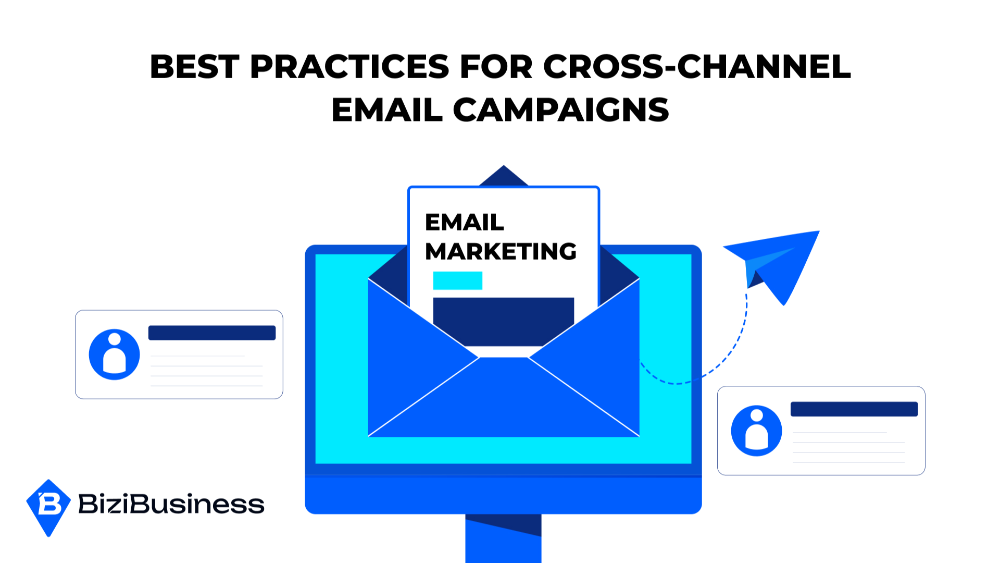
Running cross-channel campaigns isn’t about flooding every platform with the same message—it’s about creating a cohesive customer experience that feels thoughtful, relevant, and strategically sequenced. These best practices will help you do exactly that.
Keep Brand Voice and Design Consistent
Your email, SMS, ads, and on-site messages should feel like they’re coming from the same brand, not different departments. Align tone, visuals, and offers across platforms so that your audience immediately connects the dots.
Personalize Beyond the Inbox
Extend the personalization you use in email to other touchpoints. If a user clicks on a product in an email, show that same product in retargeting ads or follow up with a tailored SMS. Unified data fuels unified experiences.
Pace Your Messages Intelligently
Avoid overwhelming your audience with too many messages in a short span. Sequence content to create rhythm—not repetition. A well-timed SMS the day after an email, or an ad that shows up a few days later, builds momentum without creating fatigue.
Let Channels Play to Their Strengths
Design content to fit each channel’s format and expectations. Use email for storytelling and value delivery, SMS for urgency, social ads for visual reinforcement, and push notifications for instant prompts. Don’t copy-paste—adapt and optimize.
Trigger Journeys Based on Behavior
Move away from rigid schedules. Instead, use behavioral triggers like link clicks, product views, or cart abandonment to fire the next best message on the best-fit channel. Responsive flows outperform static sequences every time.
Test Channel Combinations and Timing
Go beyond A/B testing and optimization subject lines. Test which channel comes first, how much time to leave between messages, and whether dropping a step increases or decreases engagement. Every combination offers insight into how your audience prefers to convert.
Measure Performance Across the Journey
Single-channel metrics only tell part of the story. Use tools and platforms to evaluate how each channel contributes to the whole. Look at assisted conversions, time-to-purchase, and cross-channel engagement—not just opens or clicks.
Common Pitfalls And How To Avoid Them
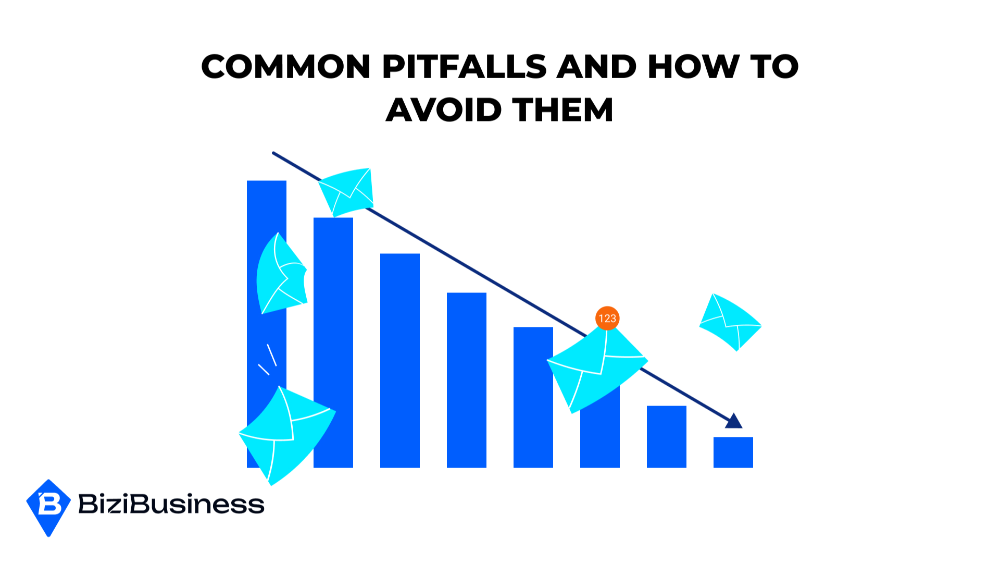
Cross-channel email marketing has massive upside—but only if executed with care. Many brands jump in with the right intentions but end up creating fragmented, confusing, or even counterproductive experiences.
Avoid these common missteps to keep your campaigns aligned, efficient, and effective.
Disconnected Data Systems
If your email platform can’t talk to your CRM or your website isn’t feeding behavioral data into your segmentation strategy and planning, you’re flying blind. Disconnected systems create gaps in visibility, misfires in automation, and missed opportunities for personalization.
How to avoid it:
Invest in integrations—or middleware tools like Zapier or Segment—that sync real-time data across your stack. Choose platforms that offer open APIs or native cross-channel support.
Redundant or Conflicting Messages
Sending a promo via email, SMS, and social—with different discounts or mixed CTAs—confuses users and undercuts your offer. It can also lead to unsubscribes, ad fatigue, or lost conversions.
How to avoid it:
Build one central campaign brief and coordinate message timing and hierarchy. Use shared calendars and clear approval processes to avoid overlap.
Channel Fatigue
More messages don’t always mean more engagement. If your audience hears from you every day on every channel, you’ll become noise—even if your content is relevant.
How to avoid it:
Use frequency caps and suppression rules. Set “smart” delays in your workflows to give users time to act before pinging them again. Monitor unsubscribes and disengagement patterns.
No Trigger Logic or Behavior-Based Journeys
Too many campaigns still rely on arbitrary timing (“3 days after signup”) rather than meaningful actions (“clicked the demo link but didn’t convert”).
How to avoid it:
Set up behavioral triggers tied to site activity, email engagement, or in-app actions. The more timely and contextual your messages, the better they perform.
Inconsistent Creative or Messaging
If your email promises a free trial, but your ad talks about 20% off, or your landing page looks totally different, users lose trust—and patience.
How to avoid it:
Use shared style guides, content templates, and QA processes. Keep message framing, visual identity, and tone consistent across all channels within the same journey.
Measuring Channels in Silos
Evaluating only email opens or SMS click rates gives you a narrow view of impact. In cross-channel marketing, the goal is orchestration, not isolated wins.
How to avoid it:
Track multi-touch attribution. Use tools that can combine performance data into unified dashboards. Measure the impact of a journey, not just a message.
Neglecting the Customer’s POV
Campaigns that feel strategic from the inside can come across as chaotic from the outside if they don’t follow the user’s intent or timing.
How to avoid it:
Map your campaigns from the customer’s perspective. Ask: Does this sequence make sense? Would I welcome this message at this time, on this channel? Build journeys for the user—not just from a marketing calendar.
Integrated Messaging Wins Every Time
Email is still one of the highest-performing channels in digital marketing—but on its own, it’s no longer enough. Your audience doesn’t live in just one place. They move between inboxes, apps, social feeds, websites, and ads—often within a single day.
That’s why cross-channel integration isn’t just a tactic. It’s a strategy for staying relevant, visible, and effective across the entire customer journey.
When your email campaigns are supported by SMS nudges, social retargeting, personalized website experiences, and behavior-based triggers, your marketing doesn’t just reach people—it resonates. You build trust, reduce friction, and create journeys that feel seamless and personal.
Integration isn’t about sending more. It’s about sending smarter. It’s about letting each channel do what it does best—while speaking in a unified voice, driven by shared data, and guided by customer intent.
Start where you are. Connect what you can. Then build, iterate, and optimize.
Because in today’s landscape, the brands that win are the ones who coordinate their messages, not compete with themselves.
Subscribe to Newsletter
Unlock your creativity and stay up to date on marketing tips
